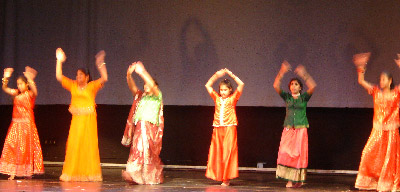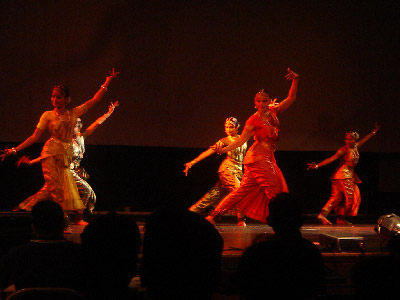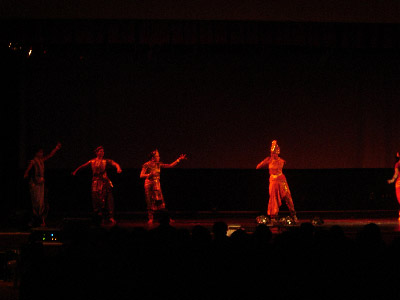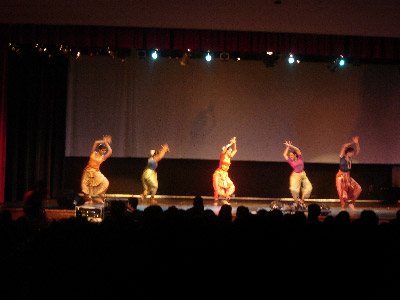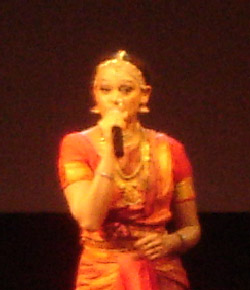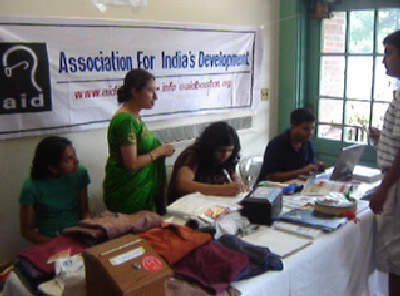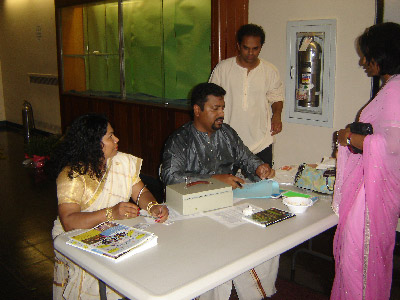Contribute
| Arabian Nights Meets Ramayana |
Ranjani Saigal
08/30/2007
Actress Shobana who is a very well-trained classical dancer, an award-winning actress and niece of the famous dancer/actress of yesteryears Padmini, presented Maya Ravan along with a collage of Bharathanatyam set to world music, with pieces of music from Spain, Western Classical and A.R. Rehman’s ever-popular Vande Mataram. The event was held at the Arlington high school on August 25, 2007 under the auspices of New England Malayalee Association (NEMA) and Association for India Development(AID).
Over 700 people attended this event and money raised was used to support
the great work done by AID in India. For more information on AID, please check http://aidboston.org.
The presentation was termed multimedia and started with a few of Padmini’s famous film clips bringing back nostalgic memories of a time in Tamil Cinema where Bharatanatyam and Carnatic Music formed the backbone of Cinema. Shobhana and her students opened the presentation with Anjali that was set to the music of Ganesh-Kumaresh. Brilliant use of line choreography and perfectly synchronized movements set to lively music made this a piece to remember.
Shobana then hooked on to the new trend in Bharatanatyam where movements are set to Flamenco music. The Nritta or pure dance movements were very creative and fit well with the Flamenco music. The music was used to tell the story of the different Avataras of Vishnu. While it was interesting, watching it made one realize why the great Bharata decided to present music and dance as an integrated whole. Music does convey a lot of the information in a story and removing Indian music from an Abhinaya piece and substituting it with Flamenco music was a big loss for the story telling. Nonetheless many members in the audience found it very entertaining. This was followed by a brilliant and classy presentation set to A.R.Rahman’s “Ma Tujhe Salaamâ€.
The next presentation, Maya Ravan was based on Ashok Banker’s version of the Ramayana. Banker has stated in an interview that his work “Prince of Ayodhya†is autobiographical in parts. Banker’s childhood was a very difficult one. Even though his biological father was Hindu, his mother and father divorced when he was only three months old and he was bought up as a Catholic by his Anglo-Indian mother who went through a rough life including drug, alcohol and sexual abuse. Writing was his release and he was able to make a career out of it. In his interview he claims a lot of his writing to be colored by his unhappy youth in a broken Anglo-Indian home and this background helps us understand the irreverent presentation of Maya Ravan where drugs, alcohol and vulgar comments with sexual overtones are an important part of his rendition.
It is important to understand the presentation in this context. Shobana’s Abhinaya, choreography and movements were very cute as she presented Ramayana’s antagonistic characters. Her costumes seemed right out of Arabian nights with Shobana looking particularly delightful as Ravana. Shobana incorporated English narration and film songs that increased the appeal of the production.
The pure dance choreography was wonderful though I did miss hearing the Jathis being stamped by the feet especially in pieces that were danced to dazzling Korvais played on the Mridangam. While the Nritta or the pure dance movemnets of the other dancers was excellent their Abhinaya was not upto par. They were either lacking in Abhinaya or did not quite understand their part well enough to know what to present. Considering the content the later could have well been the case.
While Shobana gets high marks for her own character presentation and the very innovative use of lighting, choreography and popular music, one does question the content she chose to present. Unlike the traditional Ramayana which chooses to lift each character to great heights this one chose to debase everyone.The great poetry of Tulasidas presented in the Hanuman Chalisa was trivialized by using a the version from the cartoon version of Hanumana. Apart from not bringing out the beauty of the character of the protagonists including Rama, Sita and Hanuman, the production chose to debase the antagonists like Kaikeyi, Ravana and Surpanaka. Kaikeyi was depicted as acting under the influence of Opium. Shobana used Western clothing to depict the “wicked†Surpanaka whose conversations had sexual overtones while the “good†Sita was in Indian clothes. Sita’s use of vulgar words as she referred to Ravana as a donkey was out of place. Ravana is shown drinking before his last battle instead of being at the shrine of Lord Shiva composing the Shiva Tandava Stuti.
Shobana has put together a lot of interesting dance and theatrical ideas in this production and in future it would be nice to see her pick content that fits the power of these tools and the talent of this great entertainer. There are plenty of new and interesting stories that need to be told and instead of vulgarizing classics in the name of contemporary one hopes writers and artists will use their creative juices to create new stories and uplift the Sabha or the public as Bharata intended when he wrote the Natya Shastra.
You may also access this article through our web-site http://www.lokvani.com/
